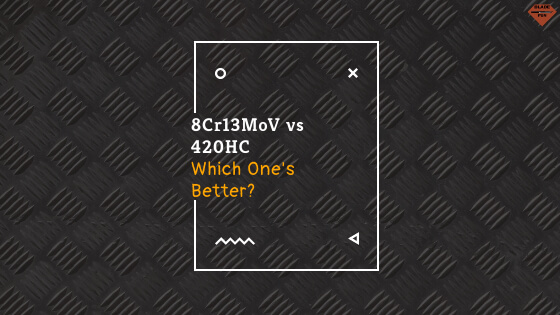8Cr13MoV and 420HC are both good budget steels used in knives–if (as with just about everything) you can get them from reputable companies. Which one’s better, though?
Well, here’s the short version:
On paper, 8Cr13MoV is better than 420HC. If all things were equal, 8Cr13MoV would hold a better edge and would be tougher and more corrosion resistant. Which one’s better mainly depends on who makes the steel: For instance, Buck has perfected 420HC and Kershaw has dialed in their 8Cr13MoV.
So, on paper, 8Cr13MoV would be better, but depending on where you get the knives from, 420HC could be better. Why is that? Let’s dive in a bit further to find out.
8Cr13MoV
8Cr13MoV is a stainless steel usually made in China. (The “stainless” part means that it’s resistant to rust.)
The seemingly cryptic name of 8Cr13MoV actually refers to the steel’s composition. The 8 refers to the percentage of carbon (0.8%), the Cr13 refers to the percentage of chromium (about 13%), the Mo refers to molybdenum, and the V refers to vanadium.
8Cr13MoV is also in a series of steel, in which you may also see steels like 8Cr14MoV. They all follow the same naming pattern: The first number, 8 in this case, denotes the percentage of carbon, 0.8% carbon in this case.
The second number, 14 in 8Cr14MoV, is the number denoting the percentage of chromium. In 8Cr14MoV, it means that it has a slightly higher composition of chromium and is thus more corrosion resistant than 8Cr13MoV.
The Mo still means molybdenum and the V still means vanadium.
The full composition of 8Cr13MoV is about:
- 0.8% carbon
- 13% chromium
- 0.3% molybdenum
- 0.25% vanadium
- 1% silicon
- 1% manganese
All those components each do different things: The carbon increases strength (it’s important to note that at high levels, carbon leads to brittleness, which means easy chipping and breaking), the chromium increases corrosion resistance, the molybdenum increases hardenability (which basically means that it’s easier to harden, and thus manufacture), and vanadium improves wear resistance and strength. Manganese increases strength and hardness. Silicon does too, but to a lesser extent.
420HC
420HC is also a stainless steel. While 8Cr13MoV is almost always manufactured in China, where 420HC is manufactured depends on the company. For instance, Buck usually makes their knives in the US.
Generally, steel made in the USA or Europe is going to be better than steel made in China, for instance. As an example, Buck’s knives made in the US with 420HC (and their proprietary 420HC heat treat) are often able to beat 8Cr13MoV. So, despite the fact that, on paper, 8Cr13MoV has more potential than 420HC, Buck’s American-made 420HC is often better than 8Cr13MoV.
Basically, where the steel is made is often indicative of how (and how well) it’s made.
420HC is the evolution of the old 420 steel, with the “HC” part standing for “High Carbon.” It’s got high carbon relative to 420, anyway, because it actually has fairly low carbon content.
The exact steel composition is around:
- 0.46% carbon
- 13% chromium
- 0.3% vanadium
- 0.4% manganese
- 0.4% silicon
Basically…
On paper, 8Cr13MoV is better. If we were to compare them in a vacuum with everything being equal, 8Cr13MoV would beat out 420HC.
Unfortunately, real life isn’t a vacuum. The performance of a steel can be affected by the heat treat, edge geometry, maintenance of the blade, and more.
Basically, if it’s made by a reputable company, chances are good that the steel will perform well. So, 8Cr13MoV and 420HC will both perform well if made by reputable companies–with 8Cr13MoV likely edging out over 420HC in terms of edge retention, corrosion resistance, and toughness. In terms of sharpenability, they’re both likely to be easy to sharpen.
If you’re looking for some reputable companies using those steels, look at Spyderco or Kershaw for 8Cr13MoV and Gerber or Buck for 420HC.
If you’re interested in learning more about knife steels and seeing more knife steel comparisons, we’ve got a bunch here.

